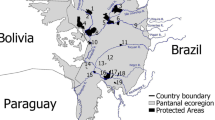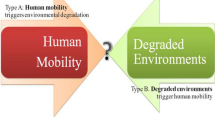This paper examines the responses of mobile pastoralists to a floodplain rehabilitation program in north Cameroon. From 1993 to 1999, we measured changes in number of camps and herds, and the time they spent in the 600 km2 of the Logone floodplain that was reflooded in 1994. The first year, few pastoralists anticipated the reflooding or its impact, and the increase in grazing intensity was caused by a prolonged stay of pastoralists who already used the area for transit. The following three years showed a sharp increase in the number of camps and herds, which stabilized from 1997 onwards. Overall, grazing intensity increased threefold, following the gradually recovering perennial grasslands, with no signs of overexploitation of the area. These developments closely match the ideal preemptive distribution model. We also examined how reflooding affected pastoral incursions in the Waza National Park located in the floodplain.





Similar content being viewed by others
Notes
Use of floodplains in the Lake Chad Basin is facilitated by international agreements (CIRAD-CTA, 1996). In principle, pastoralists have to pay a small fee per head of cattle and show certificates of herd vaccinations when they cross the border, but in practice border controls are not very strict.
A sub-ethnic group refers to a group consisting of different clan fractions that have in common a migratory history and certain cultural traits (Burnham, 1996). Other, numerically smaller nomadic FulBe groups in the Logone floodplain have been grouped with one of the three main nomadic FulBe groups with whom they associate.
Pastoralists used moon cycles and weekly market days as reference points to recall how long they had camped in particular sites. We cross-checked this information with other pastoralists.
We have considered herds as management units, i.e., the animals that graze together during daytime under the guidance of a herder, and not as property units (Dahl and Hjort, 1976, p. 134).
Initial analysis using stem-and leaf plots in SPSS (1999) showed that herd size data followed a normal distribution. Herd size data from different sources have subsequently been analyzed with t-tests, variances of herd sizes with Levene's Test for equality of variances (SPSS, 1999) to enable possible lumping. Subsequently, herd size data from different pastoral groups were lumped if results of ANOVA and Tamhane Post Hoc tests (SPSS, 1999) allowed for it.
The 27 to 69 cattle km2 increase in the reflooded area in the Logone floodplain falls within the range of aerial surveys of other African floodplains, which assessed average cattle densities from 25 to 80 cattle per km2 (e.g., DHV/LRVZ Farcha, 1994). Obviously, care should be taken to compare surveys of different scales and methodologies.
This assumption seems reasonable given the large number of animals and herds in our study, respectively 95,077 and 1,079 in 1999.
Respectively Y=0.00344 (year)‒6.9, R 2=0.91, p=0.003 and Y=0.0039 (year)‒7.8, R 2=0.87, p=0.006.
The relatively uniform floodplain vegetation masks possible quality distinctions, an issue that has not been further studied.
Although access to grazing lands for main camps is not regulated by the principle of first-come-first-served; it is the principle by which the luci herds gain access to pastures. There is increasing competition among luci herders to enter the floodplain as soon as possible, even though the partial flooding carries health risks.
In all the years of working with mobile pastoralists in the Logone floodplain, we have not come across conflicts between pastoralists over campsites or grazing ranges.
REFERENCES
Acreman, M. C., and Hollis, G. E. (1996). Water Management and Wetlands in Sub-Saharan Africa, IUCN, Gland (Switzerland).
Azarya, V., Breedveld, A., Bruin, M. de, and Dijk, H. van (1999). Pastoralists under pressure?: Fulbe societies confronting change in West Africa, Brill, Leiden.
Beauvilain, A. (1981). Élevage et éleveurs du grand yaéré (Nord Cameroun). Revue De Geographie Du Cameroun 2(2): 163–176.
Beauvilain, A. (1995). Tableau de la pluviometrie dans les bassins du Tchad et de la Bénoué de la création des stations à décembre 1994 (Vol. 3). Centre national d'appui à la recherche, Tchad.
Behnke, R. H. Jr., Scoones, I., and Kerven, C. (1993). Range ecology at disequilibrium: new models of natural variability and pastoral adaptation in African Savannas, Overseas Development Institute, London.
Braukamper, U. (1996). Strategies of environmental adaptation and patterns of transhumance of the Shuwa Arabs in the Nigerian Chad Basin. Nomadic Peoples 1 (39): 53–68.
Breman, H., and Wit, C. T. (1983). Rangeland productivity and exploitation in the Sahel. Science 221(418): 1341–1347.
Burnham, P. (1996). The politics of cultural difference in northern Cameroon, Smithsonian Institution Press, Washington DC.
Casimir, M. J. (1992). The determinants of rights to pasture: territorial organisation and ecological constraints. In Casimir, M. J., and Rao, A. (eds.), Mobility and Territoriality: Social and Spatial Boundaries Among Foragers, Fishers, Pastoralists, and Peripatetics, Berg, New York, pp. 153–204.
CIRAD-CTA (Ed.). (1996). Atlas d'élevage du bassin du Lac Tchad. CIRAD-CTA, Montpellier (France), Wageningen (Netherlands).
Dahl, G., and Hjort, A. (1976). Having Herds: Pastoral Herd Growth and Household Economy, Department of Social Anthropology, University of Stockholm, Stockholm (Sweden).
DHV/LRVZ Farcha (1994).Effectif du cheptel et systèmes de production animale de la Zone d'Organisation Pastorale. (Vol 6). Rapport Final de la Premiere Phase du Programme Ecologie Pastorale, Projet National d'Elevage, N'djamena (Chad).
Drijver, C. A, and Marchand, M. (1986). Taming the floods: environmental aspects of floodplain development in Africa. Nature and Resources XXII(4).
Hardin, G. (1968). The tragedy of the commons. Science 162(3859 (Dec 13, 1968)): 1243–1248.
Hiernaux, P., and Diarra, L. (1983). Pâturages de la zone d'inondation du Niger. In Wilson, R. T., de Leeuw, P. N., and de Haan, C. (eds.). Recherches sur les systémes des zones arides du Mali: résultns préliminaires. Repport de recherche 5. ILCA, Addis Abeba, Ethiopia, pp. 42--48.
Issa, Saibou. (2004). L'embuscade sur les routes des abords sud du lac Tchad. Politique Africaine 94(June 2004): 82–104.
Kari, S., and Scholte, P. (2001). La réhabilitation pastorale de la plaine d'inondation Waza-Logone (Cameroun): comment consolider sa réussite écologique? In Tielkes, E., Schlecht, E., and Hiernaux, P. (eds.), Atelier Regional: Les Approches De La Gestion Des Pâturages Et Les Projets De Développement: Quelles Perspectives?, Verlag Ulrich E. Grauer, Niamey (Niger), pp. 315–316.
Kouokam, R., Moritz, M., Ngantou, D., and Loth, P. (2004). Conflicts and conflict management in the Waza Logone Floodplain. In Loth, P. (ed.), The Return of the Water, IUCN, Gland (Switzerland), pp. 69–76.
Legrosse, P. (1999). Les règles d'accès des troupeaux peuls aux pâturages du Delta central du Niger (Mali). In Niamir-Fuller, M. (ed.), Managing Mobility in African Rangelands, IT Publications, London, pp. 76–96.
Mohammadou, E. (1988). Les lamidats du Diamare et du Mayo-Louti au XIX siecle (Nord Cameroun) (Vol. XXII), Institute for the Study of Languages and Cultures of Asia and Africa (ILCAA), Tokyo.
Moritz, M. (2003). Commoditization and the pursuit of piety: the transformation of an African pastoral system. Dissertation, University of California at Los Angeles, Los Angeles.
Moritz, M., Scholte, P., and Kari, S. (2002). The demise of the nomadic contract: arrangements and rangelands under pressure in the Far North of Cameroon. Nomadic Peoples 6(1): 127–146.
Niamir, M. (1990). Community forestry: herders' decision-making in natural resource management in arid and semi-arid Africa. FAO, Rome.
Niamir-Fuller, M. (1999a). Towards a synthesis of guidelines for legitimizing transhumance. In Niamir-Fuller, M. (ed.), Managing Mobility in African Rangelands: the Legitimization of Transhumance, Intermediate Technology, Publications, London, pp. 266–290.
Niamir-Fuller, M. (1999b). Managing mobility in African rangelands: the legitimization of transhumance. Intermediate Technology Publications, London.
Niamir-Fuller, M., and Turner, M. (1999). A review of recent literature on pastoralism and transhumance in Africa. In Niamir-Fuller, M. (ed.), Managing Mobility in African Rangelands: the Legitimization of Transhumance, Intermediate Technology Publications, London.
Pulliam, H. R., and Danielson, B. J. (1991). Sources, Sinks, and Habitat Selection: A Landscape Perspective on Population Dynamics. American Naturalist 137(supplement): S50–S66.
Rice, W. R. (1989). Analyzing tables of statistical tests. Evolution 43: 223–225.
Scholte, P. (2003). Immigration, a potential time bomb under the integration of conservation and development. Ambio 32(1): 58–64.
Scholte, P., Pamo, E., Donfack, P., Kari, S., Kersten, S., and Kirda, P. (1996a). Floodplain rehabilitation in North Cameroon: expected impact on vegetation, pastoralists and wildlife. In West, N. (ed.), Proceedings of the Fifth International Rangeland Congress. Society of Range Management, Colorado, pp. 492–493.
Scholte, P., Kari, S., and Moritz, M. (1996b). The involvement of nomadic and transhumance pastoralists in the rehabilitation and management of the Logone flood plain, North Cameroon. IIED Drylands Programme Issues Paper 66: 1–21.
Scholte, P., Adam, S., Kari, S., and Mbouche, J.-H. (1999). Walking a tightrope: using PRA in a conflict situation around Waza National Park, Cameroon. PLA Notes 35(June 1999): 7–13.
Scholte, P., Kirda, P., Adam, S., and Kadiri, B. (2000). Floodplain rehabilitation in North Cameroon: impact on vegetation dynamics. Applied Vegetation Science 3: 33–42.
Schrader, T. (1986). Les yaérés au Nord du Cameroun: pâturages de saison sèche (?) Aspects socio-écologiques du développement pastoral dans la plaine inondable du Logone, Leiden University, Leiden (Netherlands).
SPSS. (1999). 9.0 for Windows.
Stenning, D. J. (1957). Transhumance, migratory drift, migration; patterns of pastoral Fulani nomadism. Journal of the Royal Anthropological Institute 87: 57–73.
Turner, M. D. (1999). The role of social networks, indefinite boundaries and political bargaining in maintaining the ecological and economic resiliency of the transhumance systems of Sudano-Sahelian West Africa. In Niamir-Fuller, M. (ed.), Managing Mobility in African rangelands, IT Publications, London, pp. 97–123.
Wesseling, H., Naah, E., Drijver, C. A., and Ngantou, D. (1996). Rehabilitation of the Logone floodplain, Cameroon, through hydrological management. In Acreman, M. C., and Hollis, G. E. (eds.), Water management and wetlands in sub-Saharan Africa, IUCN, Gland (Switzerland), pp. 185–198.
ACKNOWLEDGMENTS
The stimulating discussions Wouter de Groot and his comments on subsequent drafts, as well as those of Frank van Langevelde, Han van Dijk, Selvino de Kort, Natascha Zwaal, Stephany Kersten, Piet Wit, Sean Overland, Leslie C. Moore, and three anonymous reviewers are greatly acknowledged.
Author information
Authors and Affiliations
Corresponding author
Rights and permissions
About this article
Cite this article
Scholte, P., Kari, S., Moritz, M. et al. Pastoralist Responses to Floodplain Rehabilitation in North Cameroon. Hum Ecol 34, 27–51 (2006). https://doi.org/10.1007/s10745-005-9001-1
Published:
Issue Date:
DOI: https://doi.org/10.1007/s10745-005-9001-1




